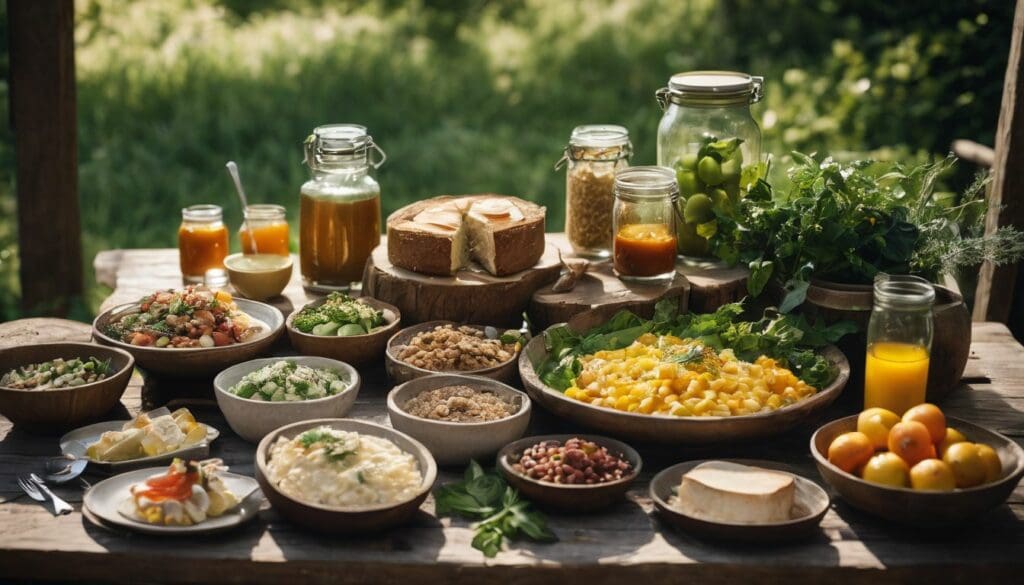Ever found yourself rooted to the spot in a supermarket aisle, perplexed by the plethora of terms like ‘organic‘, ‘sustainable‘, or ‘natural‘ adorning food packages? You’re certainly not alone.
It’s rather like trying to interpret an enigmatic code; quite a task when you’re simply aiming to fill your trolley with good choices. In fact, it turns out that well over half of us shoppers reckon food labels are more baffling than helpful.
Fear not! This blog is your secret decoder ring, brimming with insights that will guide you through the label labyrinth with gusto. Together, we’ll unravel those puzzling tags so you can stride down those aisles and select your fare with absolute assurance.
Key Takeaways
- Organic food labels such as USDA Organic, 100% Organic, and Made with Organic have specific meanings. Products with these labels are grown without synthetic pesticides or GMOs and meet strict certification standards.
- Sustainable certifications like Fair Trade and Rainforest Alliance ensure that products come from farms adhering to environmental and social criteria. Non-GMO Project Verified products do not contain genetically modified organisms.
- Labels such as cage-free and free-range signify varying levels of animal welfare practices, with Certified Humane ensuring good living conditions for animals. However, terms like ‘natural’ are not well-regulated and can be misleading.
- Hormel Foods faced legal issues over using the term ‘natural’ inappropriately on products containing additives, emphasising the need for consumers to be vigilant when interpreting food packaging claims.
- Making informed choices by understanding food label certifications aids in supporting sustainable agriculture, ethical treatment of animals, reduced chemical use in farming practices, biodiversity protection and overall environmental health.
Understanding Food Labels
Different types of food labels such as organic, sustainable, and natural can be confusing for consumers. It’s important to understand the criteria and certifications behind these labels to make informed choices about the food we eat.
Different types of labels: organic, sustainable, natural, etc.
- The USDA Organic label is a trusted mark that ensures the food is produced through approved methods. For a product to boast this label, it must consist of at least 95% organic ingredients.
- Labels reading “100% Organic” are reserved for foods made entirely from organic ingredients—this is the gold standard for organic products.
- A tag saying “Made with Organic” means the food contains at least 70% organically produced ingredients, giving you some assurance about its origins.
- Sustainable food tags point towards responsible farming practices that prioritise ecological balance. They don’t have a uniform certifying body but look out for marks like Fair Trade or Rainforest Alliance as indicators of sustainable practices.
- ‘Natural’ is a term that’s not strictly regulated and may not guarantee any specific farming practices. It’s essential to read beyond this label for clearer insight into the product’s sourcing and production methods.
- Non-GMO labels are significant if you’re aiming to avoid genetically modified organisms in your diet. The Non-GMO Project offers one such certification to keep an eye out for.
- Cage – free implies that poultry has been raised without cages, yet their living conditions might vary greatly—a deeper dive into each brand’s standards is worthwhile.
- Free – range suggests animals had some access to the outdoors; however, it’s important to verify what this entails as standards can differ considerably from one producer to another.
- Certified Humane products come from facilities that meet specific animal welfare standards regarding feeding, sheltering, and treatment.
Confusion around these labels
Understanding food labels is essential for making informed dietary choices. The terminology and nutrition information on food packages can be complex, and consumers should be equipped to navigate them effectively.
With various types of food labels existing, from organic vegetables to cage-free eggs, it can be difficult to interpret the significance of each label accurately. It’s important to grasp the truth behind claims such as “natural” or “non-GMO” amidst this labeling confusion in order to make healthy and ethical food choices without falling prey to misleading advertising tactics prevalent in the industry.
Decoding Organic Labels
Understanding the criteria for USDA organic labels is crucial in making informed food choices. From different labeling classes to what “Made with” organic means, it’s important to be aware of the distinctions.
Criteria for USDA organic label
The USDA organic label is awarded to products that meet specific criteria set by the United States Department of Agriculture. When a product is labelled as 100% organic, it means that all its ingredients have been grown and processed without synthetic pesticides, herbicides, or genetically modified organisms (GMOs).
The seal assures consumers that the product has undergone strict certification procedures to ensure its organic integrity. Additionally, the USDA also recognises two other labelling classes: products with at least 95% organic ingredients and those made with less than 70% organic ingredients but can still use the “Made with” organic label.
The USDA’s rigorous criteria for the organic label help consumers make informed choices about their food purchases. By understanding these standards, individuals can confidently select products aligned with their values regarding environmental sustainability and health consciousness.
Different labeling classes: 100%, 95%, and “Made with” organic
Understanding the precise nature of organic certification is crucial when navigating food labels. It’s not just about spotting the USDA Organic seal; we’ve got to recognise the different classes of organic labels that indicate the percentage of organic ingredients in a product. Here’s a breakdown in table form for clarity:
| Label Class | Criteria | USDA Seal |
|---|---|---|
| 100% Organic | Products must contain 100% organically produced ingredients, excluding water and salt. This is the gold standard for organics. | Allowed |
| Organic | Products must consist of at least 95% organic ingredients. The remaining 5% must be non-organic approved substances. | Allowed |
| Made with Organic | Products must contain at least 70% organic ingredients. The product can display ‘made with organic ingredients’ but cannot use the USDA seal. | Not Allowed |
We ensure you’re well-equipped to distinguish these labels so that you can make choices that align with your values and the quality you seek in your food. Let’s move on to understanding sustainable labels and their significance in supporting ethical farming practices.
Understanding Sustainable Labels
Understanding sustainable labels is crucial in making ethical food choices. Certifications such as Fair Trade, Rainforest Alliance, and Non-GMO Project are important considerations for supporting sustainable farming practices.
Certifications: Fair Trade, Rainforest Alliance, Non-GMO Project
Understanding food labels is crucial for making informed dietary choices. Here are some key certifications to look for:
- Fair Trade certification ensures that farmers and workers receive fair wages, work in safe conditions, and have a say in how their farms are run.
- The Rainforest Alliance seal signifies that a product is sourced from farms that meet rigorous environmental, social, and economic standards.
- Products bearing the Non – GMO Project Verified label are free from genetically modified organisms, providing reassurance to consumers concerned about the impact of GMOs on health and the environment.
Importance of ethical considerations in farming practices
Transitioning from decoding sustainable labels, we recognise the importance of ethical considerations in farming practices. Understanding the significance of environmentally friendly and animal welfare labels is crucial for making informed dietary choices.
With various food labels such as cage-free eggs and free-range poultry, consumers should be aware of the impact their purchasing decisions have on eco-friendly farming and animal treatment.
Consumers are encouraged to support sustainable agriculture by seeking out products with certifications like Fair Trade, Rainforest Alliance, and Non-GMO Project. Prioritising eco-friendly farming practices not only promotes healthy food choices but also contributes to ethical consumerism and animal welfare.
Other Food Labels to Consider
Explore the different labels for eggs, such as cage-free, free-range, and certified humane. Also, learn about Hormel’s controversial use of natural labeling on their food products.
Cage-free, free-range, and certified humane eggs
Understanding the differences in egg labeling is essential for making informed choices about the eggs we consume. Here are the key details about cage-free, free-range, and certified humane eggs:
- Cage-free Eggs: These come from hens that are not raised in cages, allowing them to move around more freely within a barn or other enclosed area.
- Free-range Eggs: Hens producing these eggs have access to the outdoors, giving them the opportunity to engage in natural behaviors such as foraging and scratching.
- Certified Humane Eggs: This label indicates that the hens were provided with proper living conditions, including space to roam and nest comfortably.
Hormel’s exploitation of natural labeling
Hormel Foods has exploited the term “natural” on its products, causing confusion for consumers seeking genuinely natural and eco-friendly options. The company faced a lawsuit over using additives in its Natural Choice deli meats, undermining the label’s trustworthiness.
This deceptive practice highlights the importance of scrutinising food labels to ensure that products align with personal values and dietary preferences.
Consumer confusion surrounding food labelling is exacerbated by companies like Hormel misusing terms such as “natural.” Such exploitation underscores the need for clarity and transparency in food labelling practices, empowering consumers to make well-informed choices that support their health and ethical considerations.
Conclusion: How to Navigate Food Labels
Navigating food labels can be confusing, but understanding the criteria for organic and sustainable certifications is a good starting point. Look for labels such as USDA Organic or Fair Trade, and consider ethical farming practices when making your food choices.
By being informed about food labels, you can support sustainable and ethical food practices while making healthy dietary choices.
Tips for deciphering labels
To decipher labels effectively, look for the USDA Organic seal on products to ensure they are 100% organic. Investigate certifications such as Fair Trade, Rainforest Alliance, and Non-GMO Project for sustainable options. Consider choosing cage-free or free-range eggs and poultry for ethical consumption. Look out for misleading terms such as “natural,” which may not indicate the product’s actual sustainability. Check if your food is locally sourced to support eco-friendly farming practices. Keep an eye out for greenwashing tactics used by companies to make their products seem more environmentally friendly than they actually are. Familiarise yourself with the terminology and nutrition information on food packages to make informed dietary choices.
Importance of supporting sustainable and ethical food practices
Transitioning from the tips for deciphering labels, it’s crucial to consider the significance of supporting sustainable and ethical food practices. Understanding the impact of our food choices on the environment and animal welfare empowers us to make informed decisions.
Supporting sustainable agriculture, such as organic farming, and ethical farming practices like cage-free and free-range poultry, promotes environmental conservation while ensuring humane treatment of animals.
Choosing eco-friendly farming methods helps reduce chemical pesticide use and protects biodiversity. By opting for certified organic or non-GMO products, consumers actively support sustainable agricultural practices that contribute to a healthier planet.
Moreover, endorsing ethical considerations in food production by selecting cage-free eggs or free-range poultry advocates for improved animal welfare standards within the industry.
FAQs
1. What do ‘organic’ food labels mean?
Organic food labels indicate that the produce was grown without synthetic pesticides or fertilisers, and processing aids and additives.
2. Is there a difference between ‘cage-free’ and ‘free-range’ for eggs and poultry?
Yes, cage-free means hens can roam indoors but may not have outdoor access; free-range indicates they have some access to the outdoors.
3. What does ‘sustainable’ on a food label signify?
Sustainable suggests that farming practices aim to conserve natural resources and minimise environmental impact whilst maintaining eco-friendly processes.
4. Does ‘natural’ on a label mean it’s also organic or non-GMO?
Not necessarily, as natural foods refer only to minimal processing; they’re not guaranteed to be organic or non-GMO unless explicitly stated.





